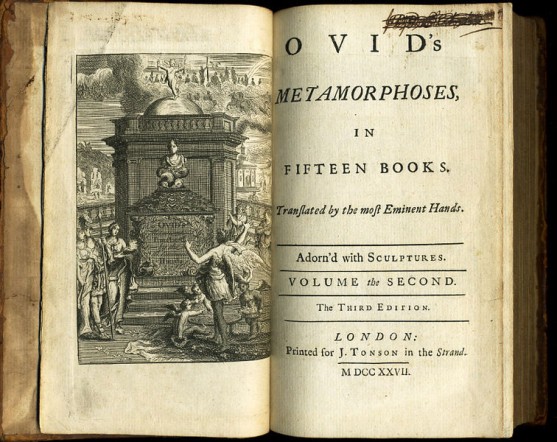(My apologies for posting this a couple days late. I’m deep in editorial revisions of my current novel Mother of Souls and am scrambling to keep up with my blogging schedule.)
We sometimes think of Greek myth as representing an ancient pre-Christian religious tradition, but many of the most elaborate and familiar sources for these stories come from relatively late, primarily literary authors who were re-working fragments and allusions into carefully crafted stories with a didactic or satirical purpose.
Many of the familiar Greek stories of transformation come down to us in their most elaborate form, not from an early Greek writer, but from the monumental poem The Metamorphoses written by the Roman poet Ovid around the beginning of the Common Era. It is from him that we get some of the more familiar versions of archetypcal transgender tales, although the ways in which he handles gender transformation would come in for serous criticism today. It must be remembered that Ovid wasn’t writing about subjective gender identites or medicalized transitions, but about “magical” transformations. In some stories, there is little subjective consideration of gender identity, it simply follows from anatomy. This approach may have worked in the 1st century, but strikes an off-key note today. In other stories, gender identification is what first comes into question and the metamorphosis brings identity and anatomy into harmony. But even in those, there can be a problematic conflation of sexual orientation and gender identity, i.e., that the nature of one’s desire is evidence regarding one’s proper (heterosexual) orientation. So while sources like Ovid provide a fascinating glimpse into historic attitudes towards gender and sexuality, to some extent they provide a guidebook in how not to handle those themes today.
Historic attitudes toward the relative worthiness of the genders influence how transformations into men versus women are portrayed. As a Roman man, Ovid was unlikely to have questioned the assumption that men were simply naturally better and more worthy than women, therefore stories about a transformation to a man are more likely to be portrayed as positive and heroic than stories about transformation to a woman.
Notwithstanding this cultural blind spot, Ovid includes an older story about the seer Tiresias who, for reasons involving offending the goddess Juno, has been transformed between male and female and back again. This makes Tiresias an idea consultant when the gods are arguing over whether men or women enjoy sex more. Juno claims that men do, Jupiter that women do. Tiresias, having experienced both sides, holds forth for women’s greater pleasure. (The underlying lesson, however, is never to get mixed up in the arguments of gods, because Juno then strikes Tiresias blind in punishment for disagreeing with her.)
The other prominent male-to-female transformation in Ovid unfortunately perpetuates a pernicious trope: that of men transforming into women to gain illicit sexual access to other women. This trope has literary echoes down the centuries and still haunts us today in the canard that supporting trans women’s rights will open the gates to predatory men pretending to transgender identity to gain access to women’s spaces. The myth of Callisto, alas, invokes that very image. Callisto was one of Diana’s nymphs and if you know anything about the goddess Diana, you know she maintained a No Boys Allowed zone. But Zeus (you just knew Zeus was going to be involved, right?) set his sights on Callisto and knew the only way to get close to her was to present himself as a woman. Being a god, he just changed into one, taking on the appearance of Diana. But now he had to convince Callisto that Diana (i.e., Zeus) wanted to be more than Just Good Friends. Then, just as Callisto finally comes to grips with having fallen in love with a goddess…nope, suprise, it’s Zeus. Joke’s on you. I told you that some of these stories were not particularly edifying.
Ovid’s story of Iphis and Ianthe became one of the iconic lesbian/transgender plots well into the modern era. Whether one views the story as lesbian or transgender depends on how one interprets Iphis’s difficulty in integrating female anatomy with sexual desire for a woman.
Iphis’s father had sworn to kill his child if it were a daughter, so Iphis’s mother told him she’d given birth to a boy, and Iphis was raised as male (though aware of the reason and context). Ianthe was the girl next door, and the two of them fell in love. Iphis’s father thought this was great and scheduled the wedding. Ianthe was overjoyed, but Iphis was deeply conflicted, believing that it was physically impossible–and should be psychologically impossible–for a girl to love a girl. Divine assistance was sought at the temple of Isis and…*zap* Iphis was turned into a boy. The wedding is celebrated. All are happy.
In the context of historic literature, one of the most valuable legacies of Iphis and Ianthe is that continuing interpretations and variations on the story provide a context for exploring the possibility of desire between women. Many of those later explorations take the story in entirely different directions. But it establishes a precedent that has proven troubling across the centuries: that of setting lesbian and transmasculine narratives in competition with each other. We’re still dealing with the legacy of that framing.
Queer Fantasy Roots explores stories and themes from history that may inspire or resonate with queer fantasy fiction being written today. Heather Rose Jones writes fantasy and historical fiction centering around queer women, and writes the Lesbian Historic Motif Blog at alpennia.com.




Interesting! I was a huge mythology geek in school (about 40 years ago) and I didn’t know all this! Thanks!